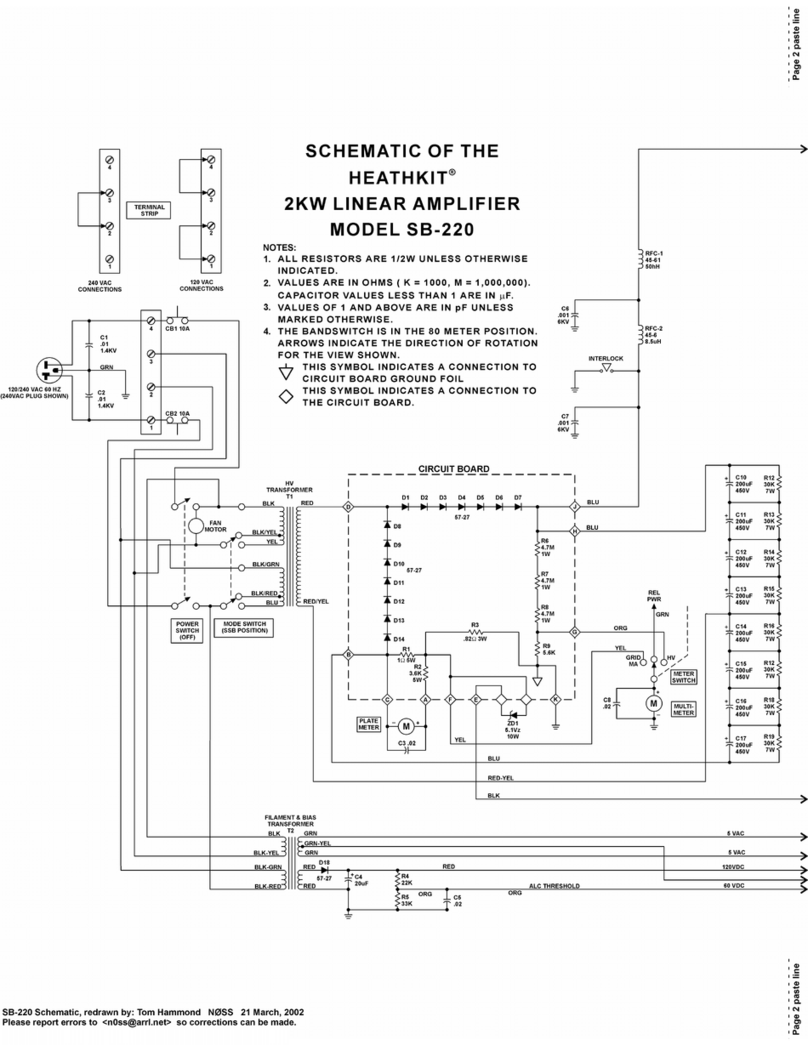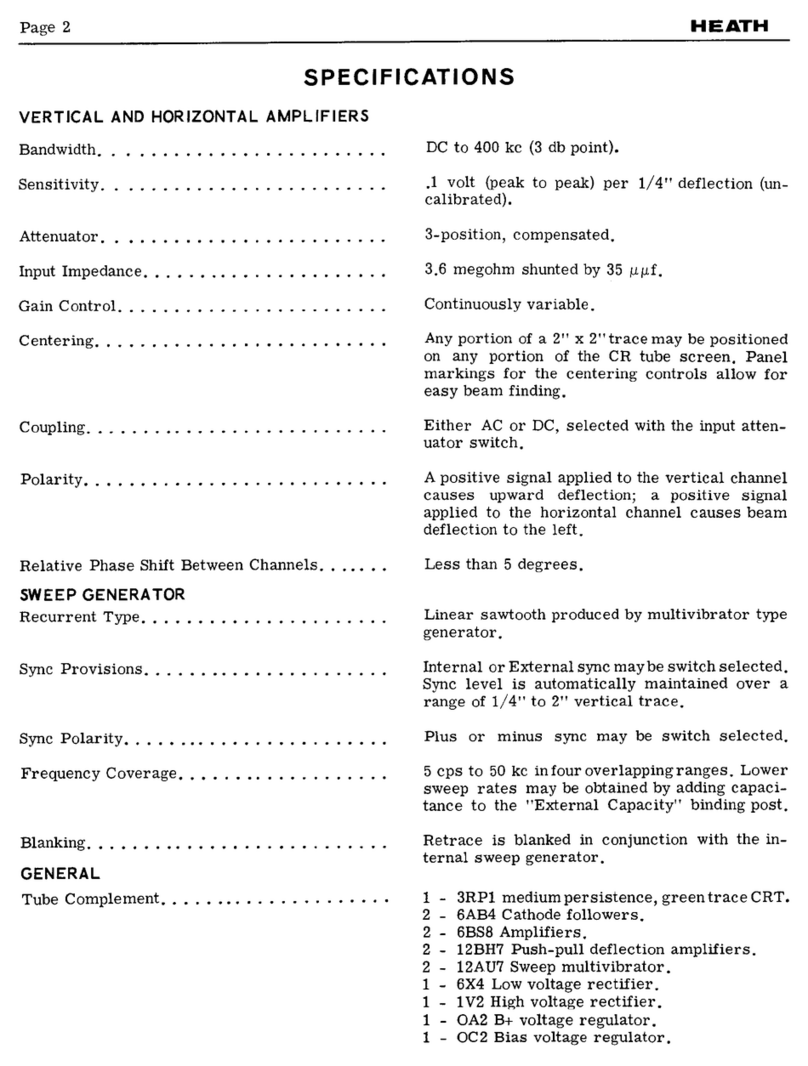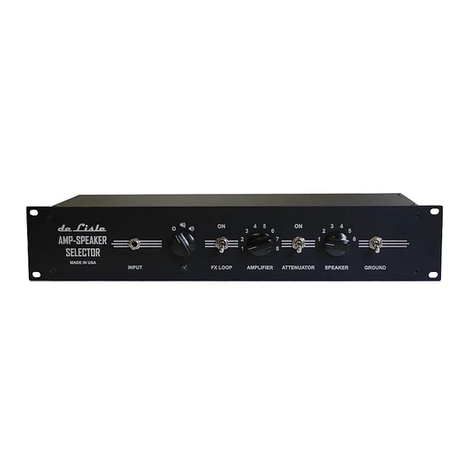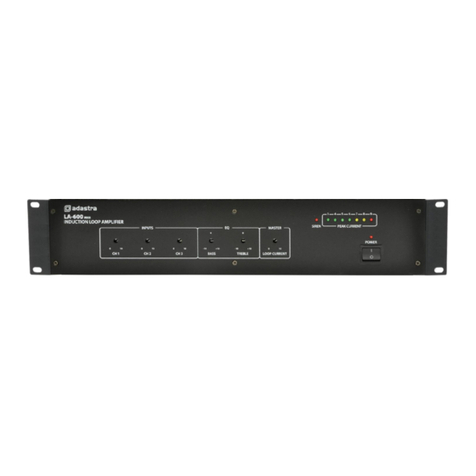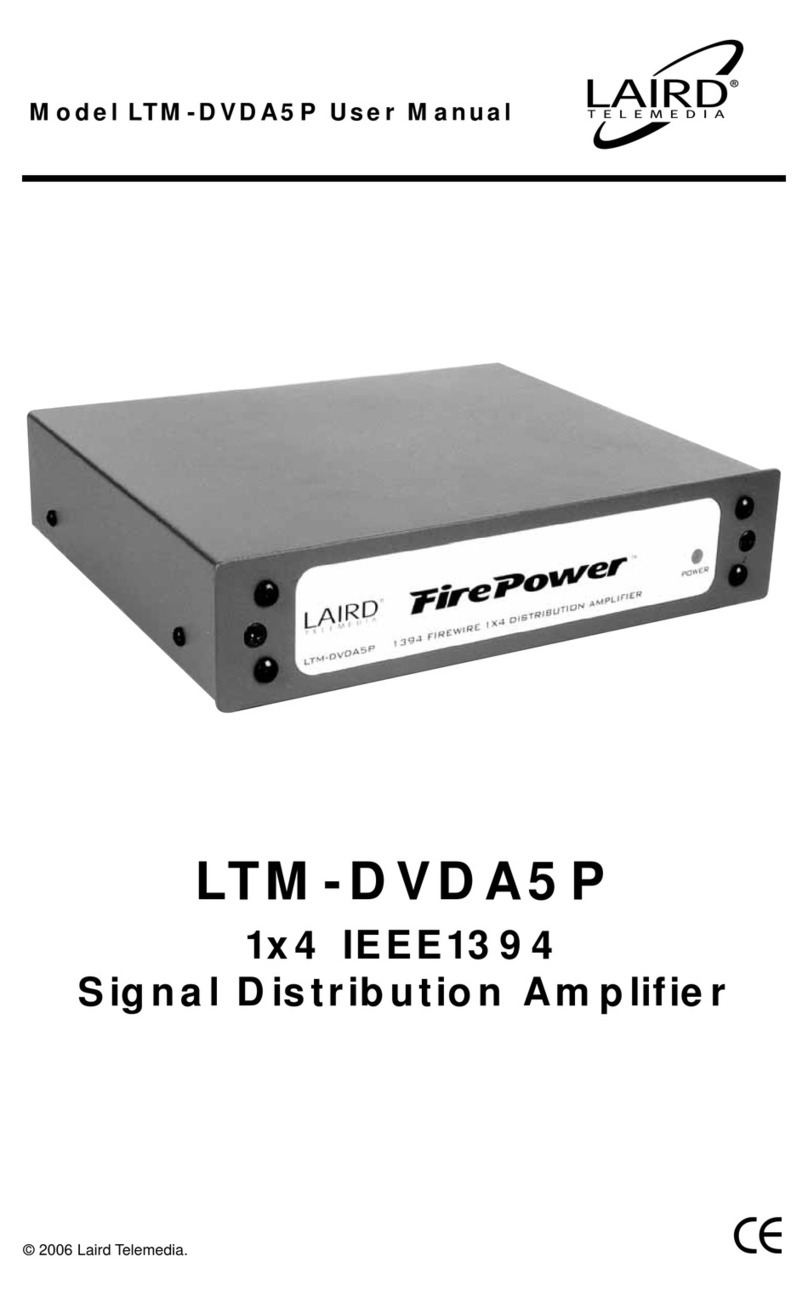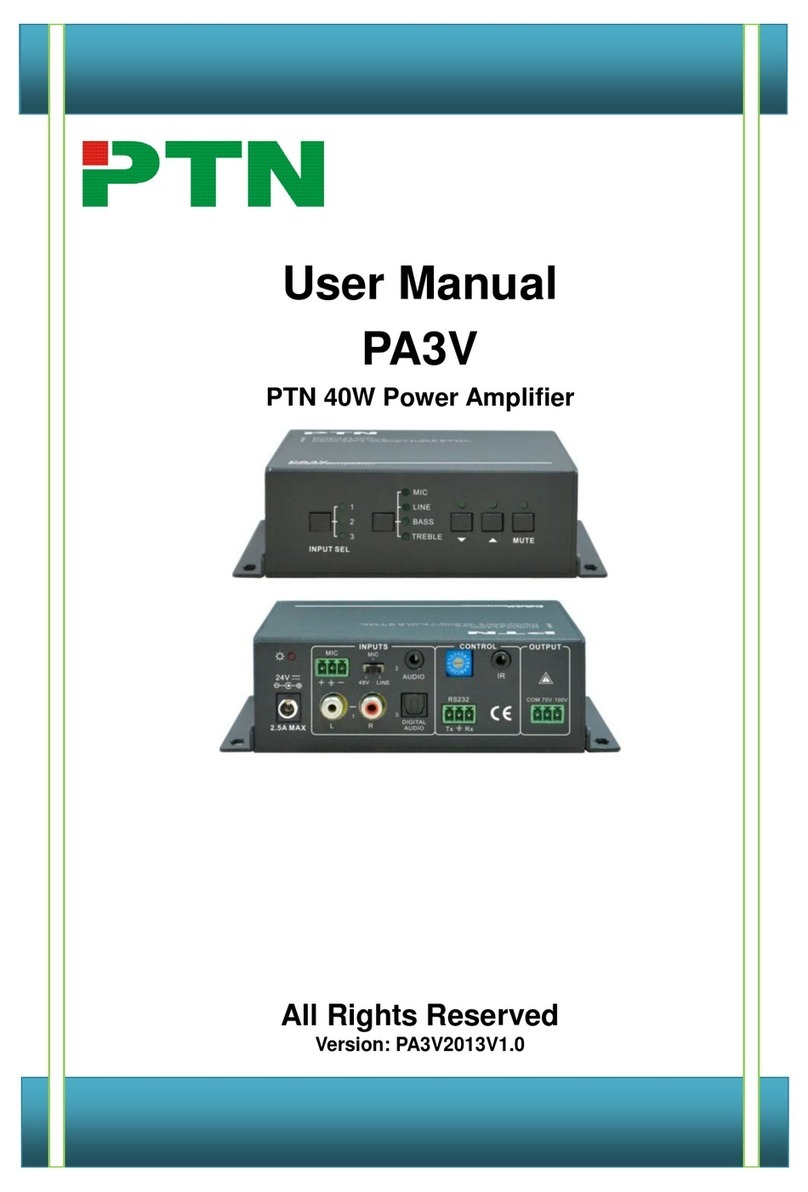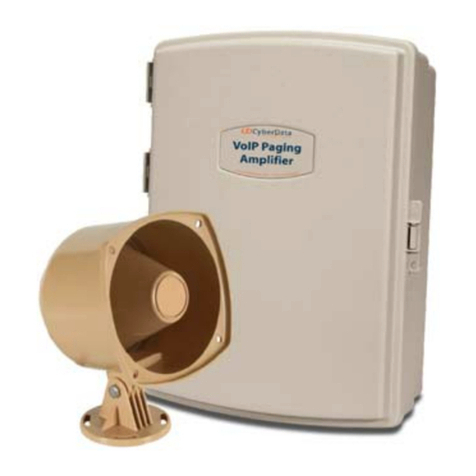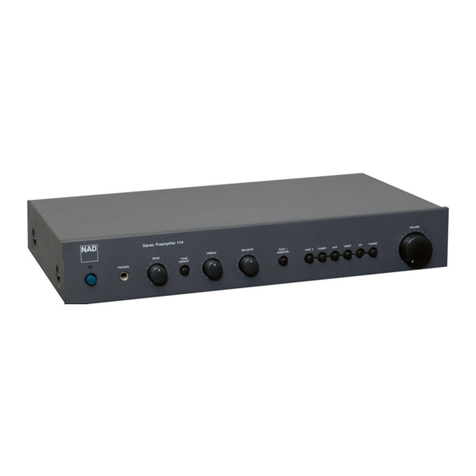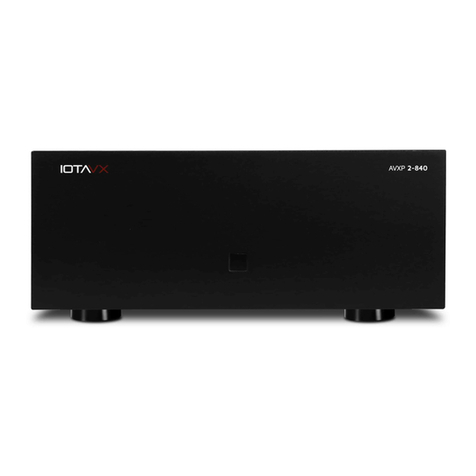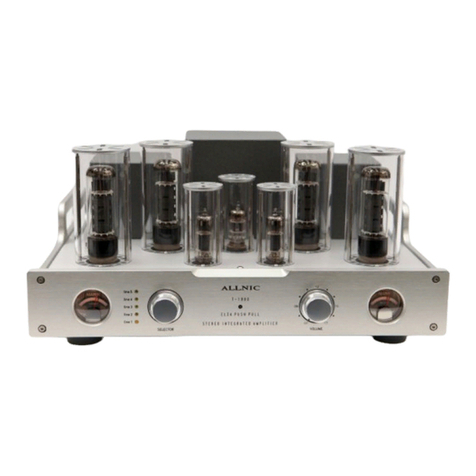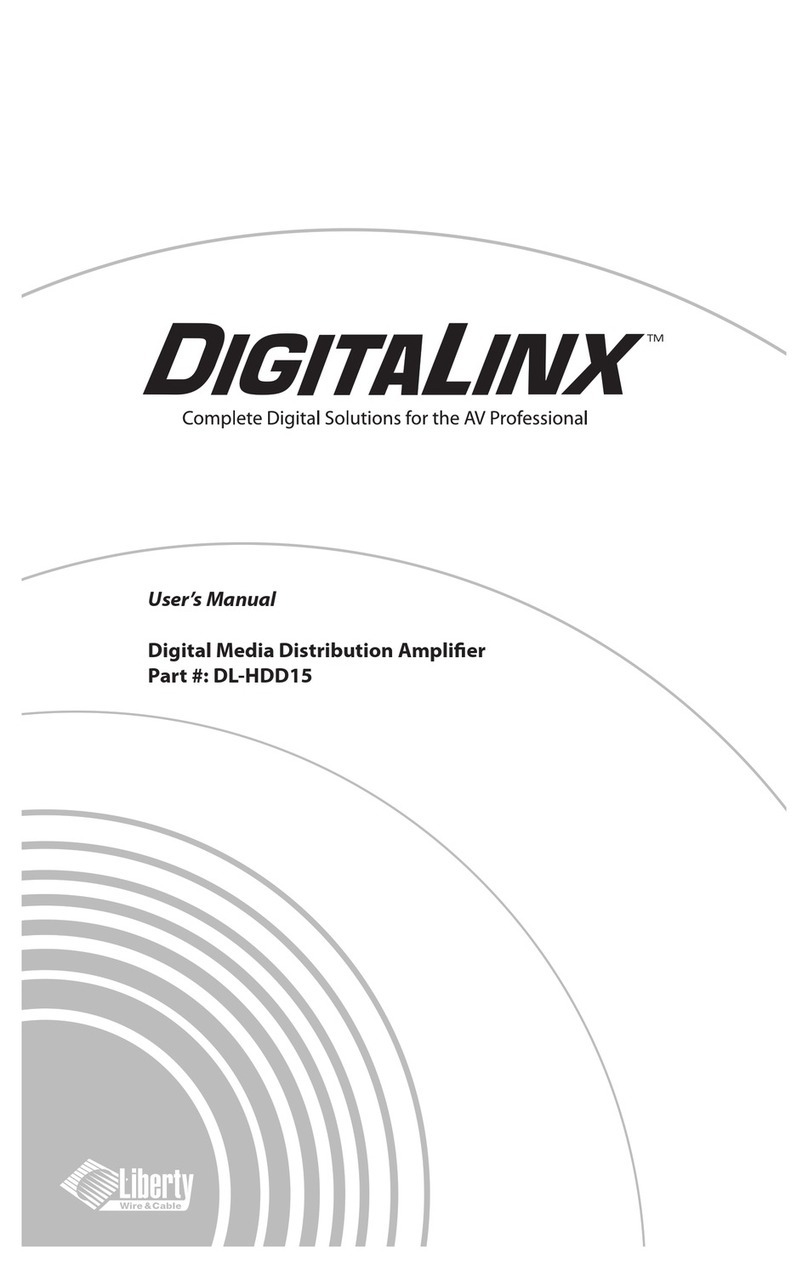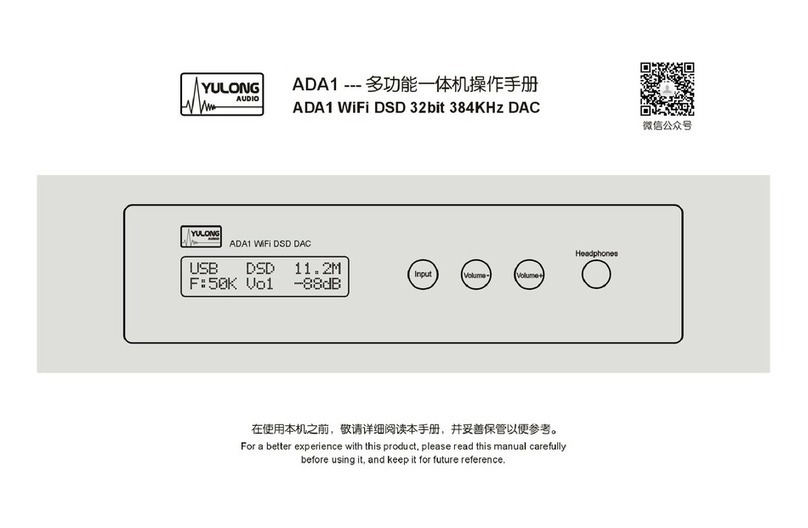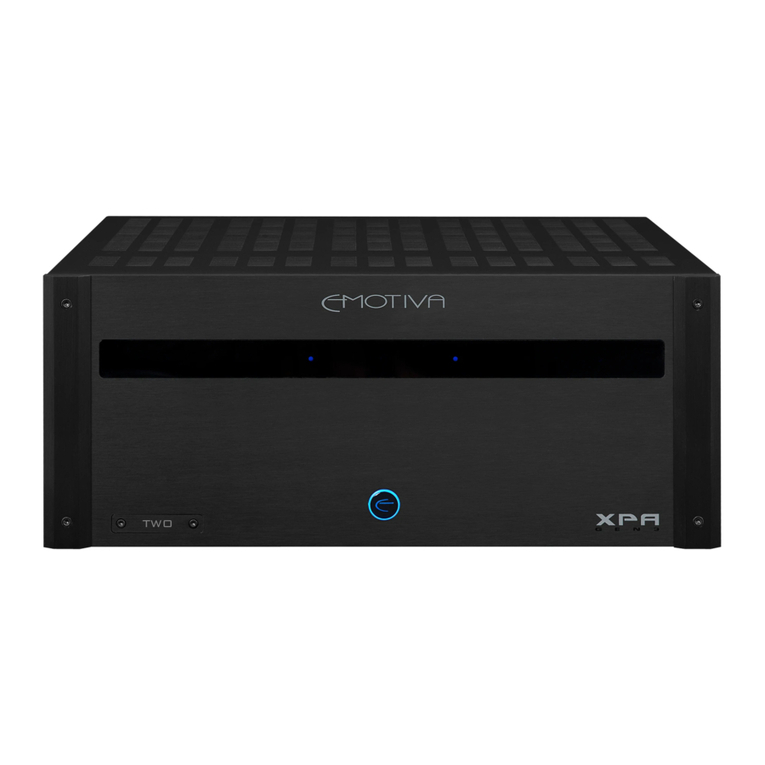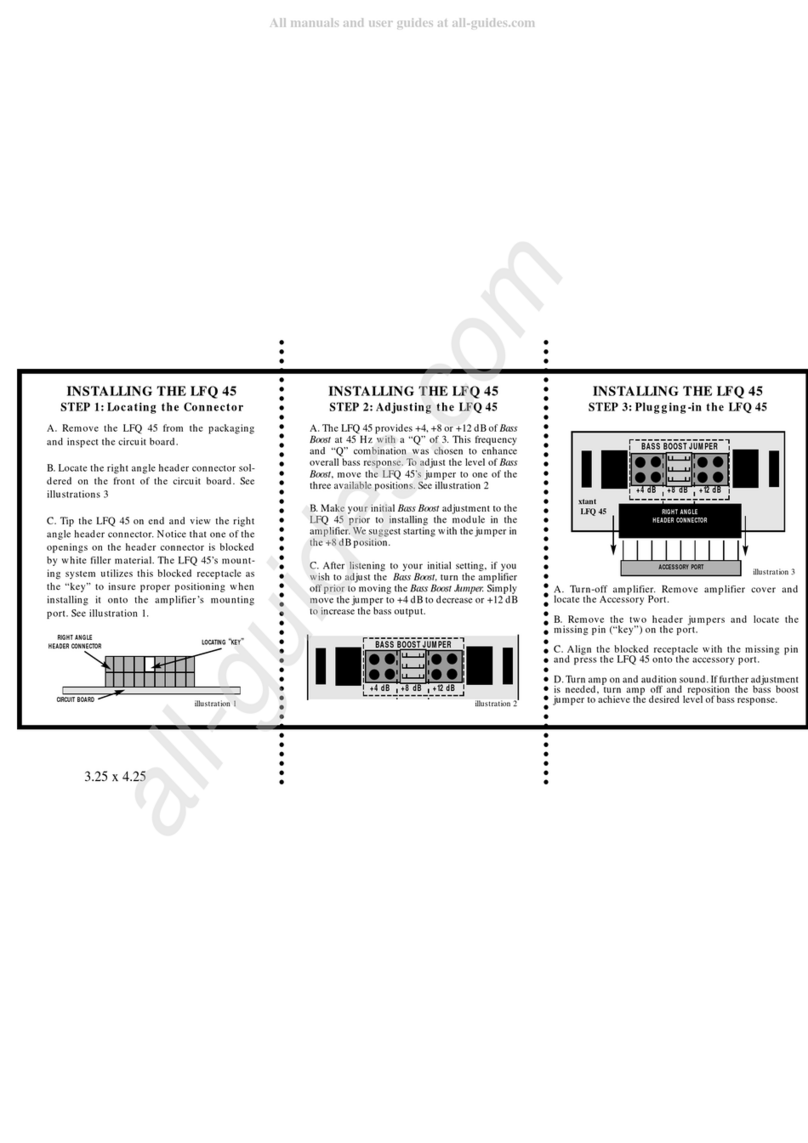Heath Heathkit W4-AM Guide

PRICE $1.00
WILLIAMSON TYPE
AMPLIFIER
MODEL W4-AM


HEATHKIT WILLIAMSON-TYPE AMPLIFIER
MODEL W4-AM
Phase Shift:


Intermodulation Distortion: See curve below. Sensitivity: See curve below.
EQUIVALENT SINGLE FREQUENCY PQWER
Hum and Noise: 76.2 db below 0.25 watts output.
95.2 db below 20 watts output.
Feedback Factor: Fixed; 22.6 db; independent of output impedance.
Damping Factor: Fixed; 28.5 to 1; independent of output impedance.
Output Impedances; 4, 8, and 16 ohms.
Input Requirements: 105-125 volts, 50-60 cycles AC, 115 watts at 117 volts.
Dimensions; Single unit; 15 1/4" x87/8" shelf space, 7" high.
Allow 11/2" XIS 1/4" additional shelf space for cables
and connections.
Weight: Net: 23 1/4 lbs.
Shipping: 28 lbs.
TEST CONDITIONS
Measurements taken at 117 volts line, with WA-P2 preamplifier connected. Output impedance
16.02 nresistive. For harmonic distortion measurements; Krohn-Hite model 440-A generator
(inherent distortion less than 0.1%), Hewlett-Packard 330-B distortion analyzer. For inter-
modulation distortion measurements; Measurements Corporation model 31 intermodulation
meter. For frequency response measurement, Hewlett-Packard model 650-A test oscillator .
For phase shift measurements, same oscillator with Tektronix 531 oscilloscope with 53-C pre-
amplifier. For output power, voltage measurements across 16.02 Dresistive load, taken with
Hewlett-Packard model 400-D vacuum tube voltmeter.
Measurements given are those taken on arepresentative amplifier under conditions stated.
Minor variations from these figures may be encountered in kit-assembled amplifiers because of
tube characteristics, component variations and exact lead placement. In ahighly stabilized
amplifier such as the W-4AM, these variables may be disregarded from aperformance point of
Page 3

INTRODUCTION
Most people are inclined to view the meteoric rise of the high fidelity craze as something which
has taken place in the last two years. Actually, public acceptance of home music reproduction
probably dates from the summer and fall of 1948 when the Columbia "LP" microgroove record-
ing techniques were introduced.
It is significant that ayear earlier, there was described in the British publication "Wireless
World," an amplifier circuit designed by Mr. D. T.N. Williamson which culminated an extensive
search for what the author described as aperfect amplifier. Within two years, the audio world
had so completely accepted the circuit that it became astandard for comparison. After eight
years, the design still accounts for by far the greater percentage of all high fidelity power am-
plifiers in use today.
Improvements have been made, faults have been discovered and corrected, other circuits have
challenged the Williamson's position, but still it stands as the basic high fidelity amplifier.
Truly, the audio field owes Mr. Williamson agreat debt.
In the past four years, literally thousands of people have built and used Heathkit Williamson-type
amplifiers. They represent alarge majority of the units of this type now in use throughout the
audio-conscious world. Your Heathkit model W-4AM Amplifier incorporates all the worthwhile
improvements and modifications resulting from this unequalled background.
If you are technically inclined, the information contained in the preceding specifications will have
satisfied your questions as to the measured performance of the amplifier. If you are interested
primarily in how the amplifier will sound,your Heathkit W-4AMis capable of placing the burden
of proof on the most elaborate and expensive speaker systems available today. Unless you have,
or expect to have, more than $300.00 to spend for aloud-speaker system, no significant im-
provement would be audible if the W-4AM were replaced with any other commercially available
power amplifier, regardless of price. If more elaborate reproducers were used, some improve-
ment at extremely low frequencies might be expected through the use of amplifiers such as the
Heathkit W-5M.
In this discussion, we have attempted to convince you that your investment in the W-4AM kit is
worthy of extreme care in construction and installation. Hurried or careless construction can
only lead to trouble, either initially or after some period of satisfactory performance. TAKE
ENOUGH TIME TO DO THE JOB RIGHT THE FIRST TIME and you will be repaid many times
in personal satisfaction and long, trouble-free service.
If you have built Heathkits before, you will note achange in the usual step-by-step procedure for
assembling and wiring. The new "all-on-one-drawing" plan used in this manual has been devel-
oped to make your work even more enjoyable.
PLEASE READ THE MANUAL ALL THE WAY THROUGH BEFORE ANY WORK IS STARTED.
Only avery small percentage of Heathkit assemblers encounter any difficulty whatsoever in com-
pleting kits of this kind. Large fold-in pictorial diagrams are included in the manual for your
convenience and are quite helpful if attached to the wall above your work space. The diagrams
are repeated in small form within the manual proper. We suggest that you retain the manual in
your files for future reference in the use of the amplifier and for its maintenance.
UNPACK THE KIT CAREFULLY AND CHECK EACH PART AGAINST THE PARTS LIST. DO
NOT DISCARD ANY PACKING MATERIAL UNTIL THIS HAS BEEN DONE. In so doing, you
will become acquainted with each part and the chance of accidentally throwing away some part
will be eliminated. Full size sketches of each of the parts categories appear on Page 16. Use
this in checking against the parts list and in identifying any questionable components.

Components with wire pigtail leads can be conveniently sorted by inserting one of the ieads into
the corrugated edge of the shipping carton flap. It may be helpful to mark the value of the com-
ponent on the flap so the part may be readily located when needed.
If some shortage is found in checking the parts, please notify us promptly and return the inspec-
tion slip with your letter to us. Hardware items are counted by weight. An occasional shortage
occurs and if this is true in your kit, please obtain the missing parts locally if at all possible.
Resistors and controls generally have atolerance rating of ±20% unless otherwise stated in the
parts list. Therefore, a 100 Kfl resistor may test anywhere from 80 KH to 120 Kfl and still be
acceptable. Tolerances on electrolytic condensers may be even wider and commonly run from
±100% to -50%. The parts furnished with your Heathkit have been specified so as to meet the
performance specifications given.
In order to e^qjedite delivery to you, we are occasionally forced to make minor substitutions of
parts. Such substitutions are very carefully checked before they are approved and the parts sup-
plied will work satisfactorily in your kit. For example, if your kit is short a15 K(2 resistor
and an 18 K£J resistor is furnished which is not in the parts list, you will understand that such
asubstitution has been made. This fact is mentioned here only to prevent any confusion in check-
ing the contents of your kit.
CAUTION: We strongly urge that you follow the wiring and parts layout shown in this manual.
The position of leads and parts is quite critical in the instrument and changes may seriously
affect the characteristics of the circuit. We do not represent that the circuit or layout of the
instrument cannot be improved; however the methods shown in this manual are the result of many
experimental models and unless the constructor has access to full laboratory facilities, we rec-
ommend that they be followed very closely.
Actual construction of the amplifier consists of three phases, each of which is covered by asingle
drawing containing all pertinent information necessary for completion:
Phase I-Assembly of parts to chassis.
Phase n-Preliminary wiring.
Phase HI -Final wiring.
These three drawings appear on the following pages of the manual. They 'are also reproduced in
much larger form as fold-in inserts included with this manual. The large drawings should be
mounted on the wall above your work space where they may be referred to readily.
Notice that each phase consists of asequence of operations, which are contained in numbered
boxes surrounding the drawing. When anote is referred to, the note will be found near the oper-
ation box where it is first applicable. At the end of each operation, asmall space is provided
(). Use this to check off each operation as it is completed. Then, if your work is interrupted
,
possibility of skipping an operation is minimized.
Start Phase Iwith operation 1, in the upper left hand corner of the drawing. Follow the steps
in numerical sequence.
Page 5


NOTES ON WIRING
Before proceeding with actual wiring of yourW-4AM kit, the following notes should be read care-
fully.
1. Notice that on the Phase II drawing, each contact of the terminal strips and other parts has
been identified by anumber. No numbering is shown for tube sockets since markings are
molded on each socket, as shown in the sketch under Step 1.
This system of numbering terminals is used to simplify wiring instructions. For example,
when an instruction reads, "Connect yellow lead to J1 (NS), "it will be understood that the
yellow lead is to be connected to terminal number 1on terminal strip J.
2. The abbreviation (NS) is used to indicate that other connections will be made to that terminal
later and the connection should not be soldered yet. When the last connection has been made
to aterminal, the abbreviation (S) in inserted indicating that the connection should be sol-
dered.
3. The term "dress" appears several times in the instructions. This means to place the cable
or lead so that it reaches to and remains near the terminal indicated. It may be necessary
to form or bend the cable slightly so that it stays in position without undue strain on the
connections.
4. "Stripand tin" means that the insulation on the lead should be removed, usuallyfor adistance
of 3/8" or so. Then twist the exposed bare strands of wire together and coat with hot solder
so the wire may be easily pushed through terminal holes without fraying out.
5. To avoid possibility of error, each color coded component is described quite completely in
the wiring instructions. On most resistors, agold or silver band will be found in addition
to the three colors called out. This fourth color may be disregarded, since it indicates only
the resistance tolerance.
6. On electrolytic condensers of the tubular type, one of the leads will be marked "positive"
by means of a+sign or other method. The instructions plainly indicate to which terminal
the positive lead is to be connected. It is very important that the condenser be connected
exactly as called out, otherwise it will be destroyed and may possibly damage other com-
ponents as well.
7. On paper dielectric condensers, usually of the molded paper type, aband or other marking
sometimes appears to designate the outside foil of the condenser. Such markings are not
significant in the W-4AM and may be disregarded entirely.
8. Before doing any soldering, read the note on the inside rear cover of this manual.
NOTE: ALL GUARANTEES ARE VOIDED AND WE WILL NOT REPAIR OR SERVICE
INSTRUMENTS IN WHICH ACID CORE SOLDER OR PASTE FLUXES HAVE BEEN
USED. WHEN mDOUBT ABOUT SOLDER, IT IS RECOMMENDED THAT A NEW
ROLL PLAINLY MARKED "ROSIN CORE RADIO SOLDER" BE PURCHASED.
9. Unless otherwise indicated, all wire used is insulated. Wherever there is apossibility of
bare leads on components shorting to other metallic objects, the leads should be protected
by useof insulated sleeving. This is indicatedin the instructions by the term "use sleeving."
10. Leads on most components are longer than they need to be. Excess lead length should be cut
off before the part is wired in place. This will not only give aneater appearance to the job,
but actually improve the operation of the equipment.
Page 7



FINAL ASSEMBLY AND TEST
This completes actual construction of the amplifier. Before the shield is added, the amplifier
must be tested and adjusted. Follow the procedure below. (If trouble is indicated at any stage
of the testing, refer to the section IN CASE OF DIFFICULTY on Page 11. Alter corrections
have been made, proceed with the tests.)
()Check the wiring very carefully against the drawings. Make sure each wire is properly
soldered. Remove any wire clippings, solder splashes or other foreign materials.
()Install tubes in the sockets as follows;
Socket A-5881 Socket C-6SN7GT Socket E-Install no tube in this
Socket B-5881 Socket D-6SN7GT socket as yet.
Be sure NO tube is installed in socket Fsince this is the power outlet for apreamplifier.
The Heathkit W-4AM Amplifier is specifically designed for use with the Heathkit model WA-P2
Preamplifier or other high-quality preamplifiers containing controls for program selection
,
tone and volume.
If you plan to use the WA-P2 preamplifier, it should be constructed at this time before any fur-
ther tests are made. If some other preamplifier is to be used, see Page 14.
Assuming that the WA-P2 preamplifier is available, proceed as follows;
()Connect the power cable of the preamplifier to the W-4AM by plugging the octal plug on the
preamplifier cable into socket Fon the W-4AM chassis. Do connect the shielded signal
cable to the W-4AM at this time.
()Connect aspeaker to the speaker terminal strip, using "C" terminal for one lead and either
the ”4," "8" or "16" terminal for the other lead, depending on the nominal impedance of the
speaker being used. This information is generally available on the speaker label or it maybe
obtained from the speaker manufacturer. In case of doubt, use the "8" terminal temporarily.
()Plug the line cord of the W-4AM amplifier into an outlet delivering 105-125 volt 50-60 cycle
AC power. DO NOT CONNECT TO ADC (DIRECT CURRENT) OUTLET, such as may be
found in some of the older districts of large cities. The amplifier will not operate on DC
and the protective fuse will be blown if so connected.
( ) Obtain aDC milliammeter with arange of not less than 75 milllamperes full scale, prefer-
ably 100 ma. Connect the positive terminal (+) to the tip of astandard phone plug such as
those used for headsets. Connect the negative terminal of the meter to the sleeve of the
plug. If such ameter is not available, it probably can be borrowed from afriend, alocal
amateur operator or the adjustments can be made in ten minutes by aradio serviceman.
(The Heathkit Handitester model M-1 is ideal fortius purpose and also would be convenient
for amultitude of other applications, should the constructor be technically inclined.)
()Insert the phone plug in either of the phone jacks.
()Apply power to the amplifier by turning TREBLE tone control on the preamplifier clockwise.
The tube filaments should light. Now turn the power off and insert the 5V4G tube in socket
E. Again turn the amplifier on and watch the meter connected to the phone plug. It should
swing upward to indicate acurrent of from 40 to 75 milllamperes. Note the reading, then
remove the phone plug and insert it in the other phone jack. Adjust the balance control L
,
between the two 5881 tube sockets so that exactly equal currents are indicated at both jacks.
NOTE; The procedure just completed assures that each of the 5881 output tubes is drawing the
same amount of current from the power supply. This balancing operation is quite critical and
affects the low-frequency distortion characteristics of the W-4AM. The calibration accuracy of
the meter is not important, so long as both tubes draw equal currents.
Page 10

()Now connect the shielded signal cable to input connector AA. Aloud "pop" should be heard
in the speaker as this is done and alow hum or rumbling sound will be evident.
(. )It theWA-P2 Preamplifier has not been tested, this work should be completed now. Follow
the instruction manual for the WA-P2 for detailed instructions.
( ) Assuming that both power amplifier and preamplifier are behaving properly, disconnect the
line cord from the outlet and attach the shield below the chassis. Remove the two power
transformer mounting screws nearest the center of the chassis. Mount the shield so that
it covers sockets Cand D, using the two transformer screws. See Figure on Page 6 for
orientation of the shield.
()Install the four rubber mounting feet in the larger holes in eachcornerof the chassis flanges.
The flat side of the foot should support the weight of the chassis.
Your Heathkit W-4AM Amplifier is now complete and ready for permanent installation. Since
there are no operating controls on the amplifier itself, no operation instructions are required
.
All control functions are supplied by the preamplifier.
IN CASE OF DIFFICULTY
If the test procedure above indicates that things are not normal, follow the plan given below:
1. Recheck the wiring. Trace each lead in colored pencil on the drawings as it is checked.
Most cases of difficulty result from wrong connections. Often having afriend check the
wiring will reveal amistake consistently overlooked.
2. Check the tubes. Most radio service shops will do this at no charge or for anominal fee
.
3. If possible, check tube socket voltages against the chart below. Agreement within 20% can
be expected. If adiscrepancy is apparent, check the wiring and components associated with
the circuit tmder suspicion.
VOLTAGE CHART
SOCKET
TUBE TYPE Pin 1Pin 2Pin 3Pin 4Pin 5Pin 6Pin 7Pin 8
Aor B
5881 NC H370 V375 VNS NS H38 V
C
6SN7GT NS 135 V4.0 VNS 135 V4.0 VHH
D
6SN7GT NS 54 V1.2 V54 V200 60 VHH
E
5V4G NC 440 V* NC 380 vac NC 380 vac NC 440 V*
F
Preamplifier Power H H 0250 V275 VSee Table, Page 13
All voltages positive DC to chassis, measured with Heathkit V-7 VTVM (11 megohm input).
Voltages measured with Heathkit WA-P2 Preamplifier connecled. Line voltage, 117 volt AC.
NC -no connection. NS -reading not significant. H-vbltage between points marked, 6.3 volts
AC. *Voltage between points marked, 5.0 volts AC.
4.
If difficulty still persists, touch socket terminal A5 with one lead of a.01 fifd paper conden-
ser, holding the condenser by its other lead. (CAUTION: Do not touch chassis or any other
metallic body with your other hand while making this test. Dangerously high voltages are
present throughout the amplifier circuit and due care should be exercised. )Adecided in-
crease in hum at the speaker should be noted. If terminal A5 is "hot" as indicated by hum
increase, try terminals BS, C2, CS, D5, D2 and Dl. At some point in this sequence, no hum

UNUSUAL TROUBLES AND CORRECTIVE PROCEDURES
Certain difficulties often appear to originate in the power amplifier but actually have their source
in associated equipment. Some of these are outlined below.
1. High hum level at the loudspeaker may be caused by several external effects. Assuming
that the W-4AM is used with aWA-P2 preamplifier, avery decided reduction in hum will be
noticed upon proper setting of the "HUM" control on the preamplifier. This will take place
at nearly the center of rotation. To check hum level, adjust the volume control for slightly
higher than normal room volume. Then lilt the pickup arm from the record or turn off
power to the tuner being used for aprogram source. The hum level at the loudspeaker
should just barely be audible at adistance of three feet or so from the speaker. Alouder
hum indicates abnormal conditions which can generally be corrected. Try the following:
(a) Reverse the line cord in its outlet for minimum hum.
(b) Try disconnecting the shield of the signal cable at the power-amplifier end where it con-
nects to the shell of the phono plug. This will prevent a"ground loop" through the shield of
the cable which might actually induce hum rather than eliminate it.
(c) Try eliminating possible "ground loops" between various program sources (phono pick-
ups, tuners, recorders, etc.) and the preamplifier by opening the shield grounds at one end
or the other.
(d) Try disconnecting each program source from the preamplifier and determine If the hum
level is affected in any way. Even idle tuners or phono pickups will occasionally develop
into hum sources because of leakage in power circuits.
(e) As alast resort, try connecting the frame orchassisof eachcomponent to agood ground
such as acold water pipe or driven ground.
2. "Motor boating" is aterm used to describe alow-frequency (2 to 5 cps) oscillation of an
amplifier system. It is generally caused by inadequate amplifier loading at low frequencies.
For example, aspeaker with anominal impedance of 160 may actually look like 150 to 200
Qat frequencies near speaker system resonance. Sufficient low frequency stability is in-
cluded in the W-4AM to prevent this difficulty in the vast majority of cases. However, all-
inclusive safety margins are quite expensive. In general, the better speaker systems are
less likely to cause trouble in this way.
Under no conditions should shielded speaker leads be used and every attempt should be made
to keep the capacity across speaker lines to aminimum. Other less frequent causes of
motor boating are:
(a) Unbalanced output tubes. Recheck balance settings.
(b) Defective filter condenser sections, either in the power amplifier or preamplifier.
(c) Feedback factor too high. Feedback is controlled by the 4.7 KQ 1watt resistor from AB2
toD3. In rare cases, it may be necessary to increase the value of this resistor to eliminate
motorboating. Achange to 6.8 KR will generally correct apersistent case, with very slight
degradation to performance in other respects.
(d) Low frequency oscillation may sometimes be triggered or touched off because of oscilla-
tion of the amplifier at asupersonic frequency around 100 kc. This type of difficulty will
cause the amplifier to sound strained or muddy. It may be readily identified by connecting
an oscilloscope across the speaker terminals. If oscillation is present, it will be evidenced
by asteady high frequency output voltage with ahighly distorted wave form. This output
voltage will exist even in the absence of input signals. The condition may be caused by an
improper or defective condenser across the feedback resistor or by improper components
in the phase correction network, the 4.7 KR resistor and 420 ppf condensers connected to
D4 and G..
Page 12

3. Output tubes will not balance. First, try interchanging the tubes in sockets Aand B. If the
unbalanced effect is also interchanged, one of the tubes is probably defective. If not, care-
fully check the wiring associated with the cathode circuits of the output tubes. Bie sure
neither of the jacks is shorting to the chassis; they should be completely free of metallic
contact to chassis except through the 360 SI bias resistor and the balancing network. Check
voltages carefully against the voltage chart if unbalance still persists. Do not attempt to
balance tubes while program material is being reproduced.
INSTALLATION
When the amplifier is completely tested, it should be permanently installed in the system. Since
no operating controls are associated with the W-4AM, it may be installed wherever convenient
with the following precautions:
(a) Allow sufficient ventilation to prevent overheating. Bear in mind that while in operation,
the unit will develop about as much heat as a150 watt lamp bulb.
(b) Provide access room for connecting cables, occasional balancing of the output tubes and
tube replacement.
(c) Protect the amplifier from dampness or physical damap. Since the tubes run very hot,
the unit should be installed where it cannot be tampered with by small children.
An AC outlet is provided on control apron of the amplifier. It may be used to supply power to a
tuner, phonograph record changer or other accessory. If used for arecord changer, be sure the
unit is allowed to pass completely thru its change cycle so it shuts itself off. Otherwise, idlers in
the changer may be left in contact with other parts causing flats to develop and ruining the idlers.
Acomplete discussion of how to install the high fidelity system is too lengthy to carry in this
manual. We suggest areview of current issues of "High Fidelity" and "Music at Home. "These
magazines carry specific sections on installation. This type of information also appears fre-
quently in other periodicals on home building and decorating.
USING THE W-4AM AMPLIFIER WITH OTHER PREAMPLIFIERS
As previously stated, the W-4AM is designed specifically for use with theHeathkit model WA-P2
Preamplifier. It may, however, be used with other preamplifiers or AM-FM tuners which in-
corporate the necessary control functions.
Sufficient power is available from the W-4AM to operate both filament and plate circuits of the
usual preamplifier where Independent power supplies are not included in the preamplifier itself.
The following circuits are available at socket F;
275 volts DC at 10 ma
117 volts AC, switched and fused
117 volts AC, not switched and fused
Line switch, to control amplifier
Socket contacts FI and F2.
Socket contact F3.
Socket contact F4.
Socket contact F5.
Socket contacts F7 and F8.
Socket contacts F6 and F8.
Socket contacts F6 and F7.
It is suggested that an adapter cable be made up to supply power and/or switching circuits to
preamplifiers other than theWA-P2. This cable should terminate in astandard octal plug, with
cap, similar to Amphenol's type 86-PM8, and may be wired in accordance with the above infor-
mation. The cable may then be connected to the W-4AM using socket F.
DO NOT, UNDER ANY CIRCUMSTANCE, EXCEED THE POWER RATINGS GIVEN ABOVE FOR
ADDITIONAL FILAMENT AND PLATE SUPPLY. To do so may seriously damage power supply
components in your W-4AM amplifier. If the preamplifier used has no provision for hum bal-
ancing through an adjustable resistor across the filament line, it will be necessary to ground
the center tap of the filament winding of the W-4AM power transformer. This can be done by
connecting to chassis the green-yellow lead passed through grommet YP. This may be done by
soldering the lead to terminal strip PI
.
Page 13

REPLACEMENTS
Material supplied with Heathkits has been carefully selected to meet design requirements and
ordinarily will fulfill its function without difficulty. Occasionally improper instrument opera-
tion can be traced to afaulty tube or component. Should inspection reveal the necessity for re-
placement, write to the Heath Company and supply all of the following information;
A. Thoroughly identify the part in question by using the part number and description found in
the manual parts list.
B. Mention the order number and date of purchase.
C. Identify the type and model number of kit in which it is used.
D. Describe the nature of defect or reason for requesting replacement.
The Heath Company will promptly supply the necessary replacement. Please do not return the
original component until specifically requested to do so. Do not dismantle the component in
question as this will void the guarantee. Ktubes are to be returned, pack them carefully to
prevent breakage in shipment as broken tubes are not eligible for repUcement. This replace-
ment policy does not cover the free replacement of parts that may have been broken or damaged
through carelessness on the part of the kit builder.
SERVICE
In event continued operational difficulties of the completed instrument are experienced, the fa-
cilities of the Heath Company Service Department are at your disposal. Your instrument may
be returned for inspection and repair for aservice charge of $6.00, plus the price of any additional
material that may be required. THIS SERVICE POLICY APPLIES ONLY TO COMPLETED
ttlSTRUMENTS CONSTRUCTED IN ACCORDANCE WITH THE INSTRUCTIONS AS STATED
IN THE MANUAL. Instruments that are not entirely completed or instruments that are modified
in design will not be accepted for repair. Instruments showing evidence of acid core solder or
paste fluxes will be returned not repaired.
The Heath Company is willing to offer its full cooperation to assist you in obtaining the specified
performance level in your instrument. Factory repair service is available to you or you may
contact the Technical Consultation Department by mail. For information regarding possible
modification of existing kits, it is suggested that you refer to any one or more of the many pub-
lications that are available on all phases of electronics. They can be obtained at or through your
local library, as well as at any electronic outlet store. Although the Heath Company sincerely
welcomes aU comments and suggestions, it would be Impossible to design, test, evaluate and
assume responsibility for proposed circuit changes for specific purposes. Therefore, such
modifications must be made at the discretion of the kit builder according to information which
will be much more readily available from some local source.
SHIPPING INSTRUCTIONS
Before returning aunit for service, be sure that all parts are securely mounted.
[
ATTACH ATAG TO THE INSTRUMENT GIVING I
NAME, ADDRESS AND TROUBLE EXPERIENCED. [
Pack in arugged container, preferably wood, usii^ at least three inches of shredded newspaper
or excelsior on all sides. DO NOT SHIP IN THE ORIGINAL KIT CARTON AS THIS CARTON IS
NOT CONSIDERED ADEQUATE FOR SAFE SHIPMENT OF THE COMPLETED INSTRUMENT.
Ship by prepaid express if possible. Return shipment will be made by express collect. Note that
acarrier cannot be held liable for damage in transit if packing, in HIS OPINION, is insufficient.
All prices are subject to change without notice. The Heath Company reserves the right to dis-
continue instruments and to change specifications at any time without incurring any obligation
to incorporate new features in instruments previously sold.
Page 14

WARRANTY
i, li present, may

PART PARTS DESCRIPTION
No. Per Kit
Resistors
1-3 2100 n1/2 watt
1-48 1390 n1/2 watt
1-5A 122 KS2 1watt
1-6 1470 Q1/2 watt
1-9 21K£1 1/2 watt
1-16 14.7 KSl 1/2 watt
1-21 215 KD 1/2 watt
1-24 133 Kfl 1/2 watt
1-25 147 KO 1/2 watt
1-26 2100 KO 1/2 watt
1-33 3470 KSl 1/2 watt
1-5A 222 KO 1watt (matched)
1-15A 147 n1watt
1-22A 11.5 KO 1watt
1-48A 14.7 KD 1watt
1-28A 2100 KO 1watt
1-llB 122 Kfi 2watt
I- lOB 247 KO 2watt (matched)
3-7G 1360 n7watt wirewound
II- 11100 ncontrol
Condensers
20-
34 1350 niif mica
21-
23 1420 fifjif ceramic
23-61 1.05 (ifd 400 volt paper
23-28 1.1 fifd 200 volt paper
23-63 4.25 jifd 400 volt paper
25-19 120 lifd 150 volt electrolytic
25-16 220 pfd 350 volt electrolytic
25-21 120-20-20-20 (rid 450 volt elec.
411-15 26SN7GT
411-35 15V4G
411-45 25881
Sockets-Jacks -Plugs -Fuse
434-42 1Phono input socket
434-20 1AC power socket
434-58 6Octal tpbe socket
436-4 2Phone jack
438-4 1Phono plug
421-2 1Fuse
A423-2 1Fuse holder short
PART PARTS DESCRIPTION
No. Per Kit
Terminal Strips-Wafer
431-1 41-lug terminal strip
431-2 12-lug terminal strip
431-4 13-lug terminal strip
431-5 14-lug terminal strip
431-13 14-screw terminal strip
481-3 1Condenser mounting wafer
Sheet Metal Parts
200-M86F101 1Chassis
206-M22 1Shield
Wire
89-1 1Line cord
340-3 1length Solid wire
344-1 1length Hookup wire
346-1 1length Sleeving
Transformers-Chokes
51-17 1Output transformer
54-29 1Power transformer
46-12 1Filter choke
Hardware
73-1 23/8" grommet
73-2 43/4" grommet
250-9 24 6-32 x3/8" screw
250-17 12 8-32 x1/4" screw
252-3 24 6-32 hex nut
252-4 12 8-32 hex nut
252-
733/8-32 hex nut
253-
10 3Flat nickel washer
253-15 2Flat fiber washer
253-
16 2Shoulder fiber washer
254-
124 #6 lockwasher, internal
254-6 7#6 lockwasher, external
254-2 12 #8 lockwasher
254-4 13/8" lockwasher
259-1 2#6 solder lug
261-1 4Rubber feet
595-107 1Instruction manual
Page 16

Table of contents
Other Heath Amplifier manuals
